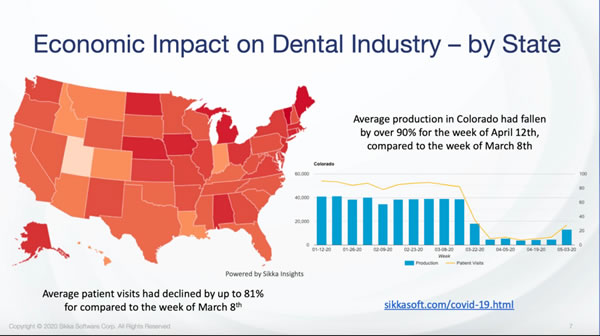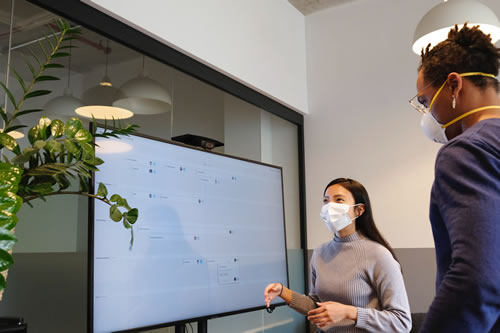The week of March 8 seems like a lifetime ago. That week was, more or less, the last one in the U.S. where things still felt “normal.” It was certainly a completely different business environment, with dental and other retail healthcare practices. This includes veterinary, optometry, and chiropractic. They were no different from restaurants, retail outlets, and other small businesses in feeling the steep revenue drop-off since then.
In the healthcare industry, dental practices have felt an acute revenue hit since they were not initially considered an essential service. Because of this designation and the shelter in place orders keeping people away, the day-to-day services of check-ups, cleanings, and cavity fillings virtually stopped. Everything else not considered an imminent health risk came to a standstill until just recently. With revenue grinding to a halt, most dental practices had to furlough their employees or lay them off.
Data from my company’s COVID-19 “Rebound Map” details the catastrophic drop in production and visits (~80%) compared to pre-crisis levels.

The dental industry rebound is well underway, though it varies by state
On a more positive note, the data also shows that an industry rebound is now well underway. According to the American Dental Association (ADA), approximately two-thirds of dental offices across the country have reopened for routine care.
Here’s what Sikka Software’s data is showing (for week ending June 7, 2020):

Note: The dip for the week ending May 31 was a result of the Memorial Day weekend.
More states are easing off their movement and business opening restrictions. This includes populous states like California and New York that implemented more stringent guidelines. These states have been more conservative in reopening. Therefore, these numbers will continue to increase in the near term. The states that opened earlier have seen a more symmetrical U-shaped graph. Meanwhile, those that moved more slowly have seen a delayed U. A few state-specific examples (as of early June) from the rebound data: Ohio’s dental practice production is up 756% from its COVID-19-induced low point. Colorado is up 546%. California is up 197%. New York is up 136% (49th place among all 50 states).
It’s important to note that there was, understandably, a great deal of fear and uncertainty with both patients and dental professionals about how bad things would get from both a health and business perspective. But in my conversations with industry professionals, the vast majority of people are proving to be comfortable with coming back. Part of that is certainly being used to the new way of being out in public. Another major factor is the way the industry as a whole got out ahead of the dire predictions. They communicated with patients in an open and transparent way.
The initial dental production increases were due mainly to orthodontic, implant and other, more involved procedures. That was expected because there seems to have been pent-up demand due to the crisis closures. The good news I’m seeing now is that preventative, diagnostic and restorative visits are starting to come back.
Good news on the technology front
One of the biggest positive developments that I believe will come out of this tumultuous period is the dental industry more fully undergoing a digital transformation, like many other industries already have.
Some of the changes happening now on the technology front not only put dental practices more in line with what other healthcare providers are doing, but also with the way we conduct the rest of our lives. This is online, immediate, and built for self-service.
From a patient’s perspective, think about filling out patient forms. What was once a tedious, manual task required every year or so will be a casualty of the “touchless” world we now inhabit. The technology for patients to provide this information digitally has been available for years, and now it will be standard practice in dental and other retail health practices.
The same goes for payments. We can purchase just about anything we want online and immediately. Now, more dental practices, including those offering subperiosteal implant procedures, are getting on board with this trend. They are using payment portals that eliminate in-person and manual processes (sorry, U.S. Postal Service). There are proven and reliable tech solutions purpose-built for dental and other retail healthcare practices available. These replace all the manual and time-consuming financial processes and are low- or no-touch. There is simply no reason for any practice to have to use paper or process transactions in person in 2020.
Another critical – and time-consuming and inefficient – process is scheduling. Phone calls and making appointments in the office are a dying breed. As with payments, the technology has been around for a while to make scheduling all-digital and text-based. But many practices saw no urgent need to upgrade. Again, that’s changed.
Even patient communication, once the domain of the telephone call and voicemail message, is moving quickly to the way most of us already communicate in our daily lives – texting.
There’s a lot more to running a dental practice, as any dentist will tell you. I’m just presenting a few of the most time-consuming and costly business processes to demonstrate the trend of digital transformation brought on by the COVID-19 crisis.
Care delivery is also being forced to change with the times
There’s a separate and equally game-changing challenge now happening on the care delivery side of running a dental practice. If you’ve been to the dentist in the past few weeks, you have already experienced the parking lot check-in. This is after texting to let them know you are there. You’ve had your temperature checked and been escorted into the office, where there is no receptionist seated behind a desk or other patients in the waiting room. There aren’t even magazines or pens lying about…or anything one might touch. And this is before you step into the operational area.
All of the above and a lot more experiential changes are material for another byline, however. But suffice to say, the equipment, outer garments, facial coverings and other preventative measures are quite different from what you remember. It looks to be that way for the foreseeable future, not just the next few months as practices reopen.
Things are looking up, but much more needs to be done
While the dental rebound we’re seeing nationwide is great news on one hand, it needs to be put in perspective. We still have a long way to go before we get back to where we were at the beginning of March. There are physical, financial, and psychological hurdles to be dealt with and overcome. The previously “normal” dental experience is gone forever, and we all have to come to terms with that.
But I’m optimistic. The overall production statistics are all trending strongly upward. Dentists, hygienists and support staff are getting back to work, and practices are starting to generate revenue again. And patients are not only receiving urgent and critical care but also preventative care, too. Whoever thought going back to the dentist would be something we want to do? Yet here we are!












Comments are closed.